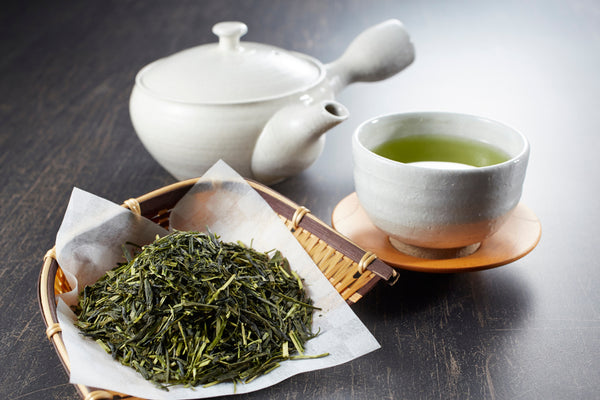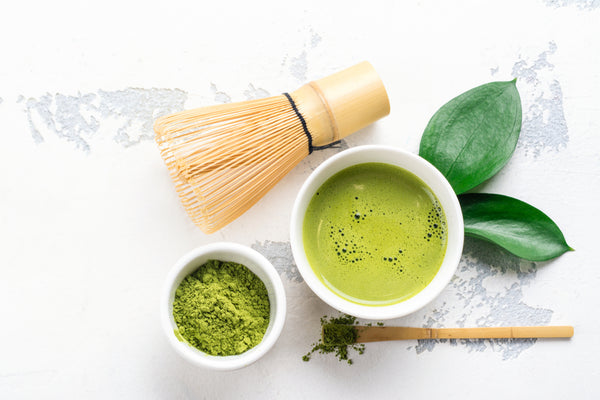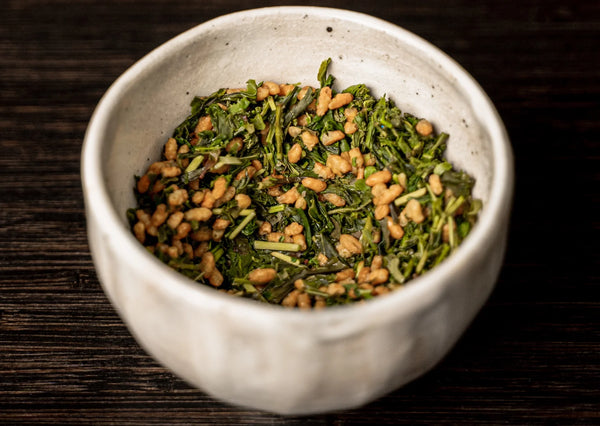Matcha tea powder, which hails from Japan, has become increasingly popular in the western hemisphere. We think it’s fantastic that tea is becoming more popular in the United States and that tea culture is quickly growing. While matcha is obviously our go-to, there is actually a wide variety of Japanese green teas, and all deserve a moment in the spotlight.
Read on to find out more about different types of Japanese teas and their unique properties.

What is green tea?
All true teas (i.e., green, white and black tea, not herbal) come from the plant Camillia sinensis. The differences in color and flavor are determined by the variety of Camillia sinensis used and the way tea leaves are grown, picked, and processed. To make green tea, oxidation is halted, keeping the tea leaves green. It is one of the least processed types of tea, and this lack of heat keeps a higher number of beneficial antioxidants and polyphenols present.
Green tea has been praised for its many health benefits. Numerous studies show that consuming green tea regularly may help improve cardiovascular health and reduce cancer risk, as well as improve skin, help with weight loss, and decrease the risk of many other chronic diseases.
Learn more about the difference between white tea and green tea.
Difference between Chinese green tea and Japanese green tea

Green tea is a favorite in both China and Japan and while there are many similarities between the types of green tea grown and produced in China and Japan, there are a few differences.
Green tea originated in China and was first documented in the Tang dynasty (618-907 AD), although it had likely been used long before then. It arrived in Japan around 800 AD from a Japanese Buddhist monk who was studying in China. Green tea was initially reserved for the high classes in both China and Japan. Japanese tea ceremonies were established around the 16th century.
The main difference between the green teas produced in these two distinct countries is the way the leaves are heated. In China, dry heat is most commonly used. This involves a pan or wok, which is generally a bit hotter and gives the tea a more roasted, sweeter flavor profile.
In Japan, wet heat is more commonly used. Tea leaves are more typically steamed, which gives them a stronger umami flavor.
Chinese green tea varieties are then typically shaped into various forms, such as feathers or tiny spirals. Japanese green teas are often turned into a powder (matcha) or rolled into small needles (Sencha).
Read more about the different types of powdered green tea.
Japanese green teas:

Sencha
Sencha is one of the most popular types of green tea. It is grown in full sun, and the leaves are harvested, steamed, and rolled before being allowed to dry. It has a vegetal and sweet taste.
Matcha
To make matcha, the tea plant is shaded the final few weeks before harvest, and leaves are then ground into a very fine powder. Because the whole tea leaf is used, matcha has a higher number of antioxidants and the amino acid L-theanine, which counteracts the unpleasant side effects of caffeine. Matcha is bright green in color and has a delicious umami, vegetal, and sweet taste.
Genmaicha

Genmaicha translates to “brown rice tea.” It is a blend of dried Sencha leaves and toasted brown rice. Genmaicha is known to be satiating, energizing, and uniquely flavored. It is sometimes called the “people’s tea” as it developed as a more cost-effective tea option due to the rice content.
Gyokuro
Gyokuro is a shade-grown tea, and only first-harvest leaves are used. It is highly prized and known to be one of the finest loose-leaf Japanese teas available. It’s processed much like Sencha and has a high chlorophyll content, which gives the tea a dark blue-green coloring. It also has an L-theanine content similar to matcha.
Kukicha
Kukicha comes from young tea twigs and stems that have been separated from Sencha during processing. It is naturally very low in caffeine, making it an excellent choice for people of all ages. It’s lighter and naturally sweet in flavor.
Hojicha

Hojicha comes from the stems and leaves of the tea plant. It can be enjoyed in its whole form or ground into a very fine powder. Due to the roasting process, it has a dark, caramel color despite being a green tea. It’s often described as having an earthy chocolate flavor and works well in lattes and baking.
Bancha
Bancha tea leaves are harvested in late summer and processed very similarly to Sencha. The increased sunlight allows more antioxidants to develop and reduces the amount of chlorophyll and L-theanine.
Konacha
Konacha is made from the small fragments left behind after making Sencha. It has a strong flavor and is traditionally served at sushi restaurants.

Bottom Line:
There are many different types of green teas unique to Japan, and all have a time and place. Whether you are looking for a tea with a high antioxidant and L-theanine content (matcha) or something more suitable for late afternoon (kukicha), there is something out there for every occasion.







